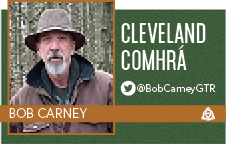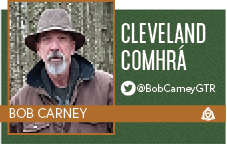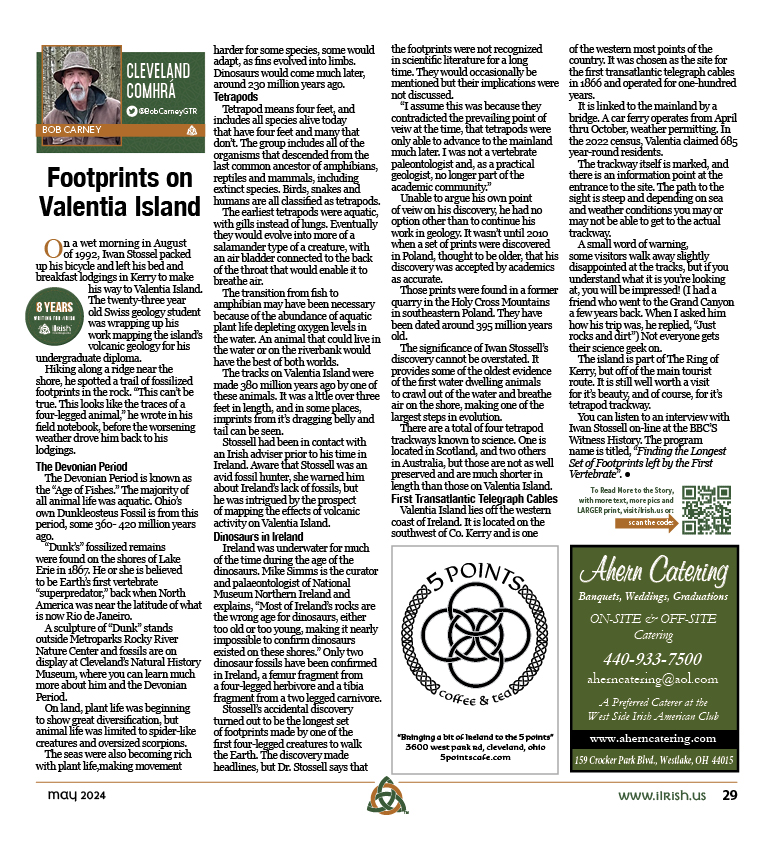

By Bob Carney
On a wet morning in August of 1992, Iwan Stossel packed up his bicycle and left his bed and breakfast lodgings in Kerry to make his way to Valentia Island. The twenty-three year old Swiss geology student was wrapping up his work mapping the island’s volcanic geology for his undergraduate diploma.
Hiking along a ridge near the shore, he spotted a trail of fossilized footprints in the rock. “This can’t be true. This looks like the traces of a four-legged animal,” he wrote in his field notebook, before the worsening weather drove him back to his lodgings.
The Devonian Period
The Devonian Period is known as the “Age of Fishes.” The majority of all animal life was aquatic. Ohio’s own Dunkleosteus Fossil is from this period, some 360- 420 million years ago.
“Dunk’s” fossilized remains were found on the shores of Lake Erie in 1867. He or she is believed to be Earth’s first vertebrate “superpredator,” back when North America was near the latitude of what is now Rio de Janeiro.
A sculpture of “Dunk” stands outside Metroparks Rocky River Nature Center and fossils are on display at Cleveland’s Natural History Museum, where you can learn much more about him and the Devonian Period. On land, plant life was beginning to show great diversification, but animal life was limited to spider-like creatures and oversized scorpions.
The seas were also becoming rich with plant life, making movement harder for some species, some would adapt, as fins evolved into limbs. Dinosaurs would come much later, around 230 million years ago.
Tetrapods
Tetrapod means four feet, and includes all species alive today that have four feet and many that don’t. The group includes all of the organisms that descended from the last common ancestor of amphibians, reptiles and mammals, including extinct species. Birds, snakes and humans are all classified as tetrapods.
The earliest tetrapods were aquatic, with gills instead of lungs. Eventually they would evolve into more of a salamander type of a creature, with an air bladder connected to the back of the throat that would enable it to breathe air.
The transition from fish to amphibian may have been necessary because of the abundance of aquatic plant life depleting oxygen levels in the water. An animal that could live in the water or on the riverbank would have the best of both worlds.
The tracks on Valentia Island were made 380 million years ago by one of these animals. It was a lttle over three feet in length, and in some places, imprints from it’s dragging belly and tail can be seen.
Stossell had been in contact with an Irish adviser prior to his time in Ireland. Aware that Stossell was an avid fossil hunter, she warned him about Ireland’s lack of fossils, but he was intrigued by the prospect of mapping the effects of volcanic activity on Valentia Island.
Dinosaurs in Ireland
Ireland was underwater for much of the time during the age of the dinosaurs. Mike Simms is the curator and palaeontologist of National Museum Northern Ireland and explains, “Most of Ireland’s rocks are the wrong age for dinosaurs, either too old or too young, making it nearly impossible to confirm dinosaurs existed on these shores.” Only two dinosaur fossils have been confirmed in Ireland, a femur fragment from a four-legged herbivore and a tibia fragment from a two legged carnivore.
Stossell’s accidental discovery turned out to be the longest set of footprints made by one of the first four-legged creatures to walk the Earth. The discovery made headlines, but Dr. Stossell says that the footprints were not recognized in scientific literature for a long time. They would occasionally be mentioned but their implications were not discussed.
“I assume this was because they contradicted the prevailing point of veiw at the time, that tetrapods were only able to advance to the mainland much later. I was not a vertebrate paleontologist and, as a practical geologist, no longer part of the academic community.”
Unable to argue his own point of veiw on his discovery, he had no option other than to continue his work in geology. It wasn’t until 2010 when a set of prints were discovered in Poland, thought to be older, that his discovery was accepted by academics as accurate.
Those prints were found in a former quarry in the Holy Cross Mountains in southeastern Poland. They have been dated around 395 million years old. The significance of Iwan Stossell’s discovery cannot be overstated. It provides some of the oldest evidence of the first water dwelling animals to crawl out of the water and breathe air on the shore, making one of the largest steps in evolution.
There are a total of four tetrapod trackways known to science. One is located in Scotland, and two others in Australia, but those are not as well preserved and are much shorter in length than those on Valentia Island.
First Transatlantic Telegraph Cables
Valentia Island lies off the western coast of Ireland. It is located on the southwest of Co. Kerry and is one of the western most points of the country. It was chosen as the site for the first transatlantic telegraph cables in 1866 and operated for one-hundred years.
It is linked to the mainland by a bridge. A car ferry operates from April thru October, weather permitting. In the 2022 census, Valentia claimed 685 year-round residents.
The trackway itself is marked, and there is an information point at the entrance to the site. The path to the sight is steep and depending on sea and weather conditions you may or may not be able to get to the actual trackway.
A small word of warning, some visitors walk away slightly disappointed at the tracks, but if you understand what it is you’re looking at, you will be impressed! (I had a friend who went to the Grand Canyon a few years back. When I asked him how his trip was, he replied, “Just rocks and dirt”) Not everyone gets their science geek on.
The island is part of The Ring of Kerry, but off of the main tourist route. It is still well worth a visit for it’s beauty, and of course, for it’s tetrapod trackway.
You can listen to an interview with Iwan Stossell on-line at the BBC’S Witness History. The program name is titled, “Finding the Longest Set of Footprints left by the First Vertebrate”:
Click or Copy and Paste




See more of Bob’s Cleveland Comhrá columns HERE

*Bob Carney is a student of Irish language and history and teaches the Speak Irish Cleveland class held every Tuesday at PJ McIntyre’s. He is also active in the Irish Wolfhound and Irish dogs organizations in and around Cleveland. Wife Mary, hounds Rían, Aisling and Draoi and terrier Doolin keep the house jumping. He can be reached at [email protected]
ends


Monthly newsmagazine serving people of Irish descent from Cleveland to Clearwater. We cover the movers, shakers & music makers each and every month.
Since our 2006 inception, iIrish has donated more than $376,000 to local and national charities.
GET UPDATES ON THE SERIOUS & THE SHENANIGANS!